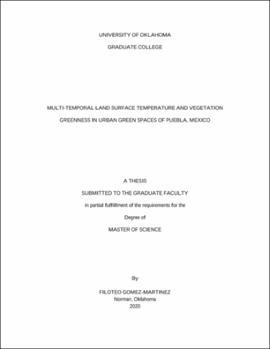| dc.description.abstract | Urban heat islands (UHI) are a global problem that is likely to increase in the future as our global urban population increases. Multiple studies conclude that urban green spaces and urban waterbodies can reduce UHI impacts, as green spaces provide many environmental and social benefits for the well-being of the residents. However, previous studies often treat urban green spaces (UGS) as static, and other studies greatly limit the number of UGS investigated. Cognizant of these shortcomings, I investigate eighty UGS in Puebla, Mexico, over a 33-year period (1986-2019), with the goal of improving our understanding of UGS characteristics that provide the most cooling to remediate UHI impact. I personally visited 73 of the UGS and recorded the land cover types as well as other characteristics to provide a good baseline understanding of most of the UGS in the study. I also used visible, infrared, and thermal data recorded by the Landsat 5, 7 and 8 sensors. First, I calculated the normalized difference vegetation index (NDVI) for each satellite image. Next, I standardized these NDVI values to mitigate seasonal differences and calculated the slope, p-values, and adjusted r-squared for the relation against time. To retrieve the land surface temperature (LST) from the thermal bands between 2000 and 2019, I applied the Radiative Transfer Equation (RTE). I found that UGS with Indian Laurel vegetation cover were much greener and remained relatively stable compared to UGS with mixed vegetation cover. Similarly, UGS with large waterbodies were cooler than UGS with small water cover. My results show that larger UGS were significantly cooler (p<0.01) and that the size of the UGS can explain almost 30% of the LST variability. Furthermore, greener UGS were significantly cooler (p<0.01), although this relationship appeared to strengthen over time, with only 16.5% of the variability in LST explained by NDVI in 2000, which increased to 42% by 2019. | en_US |
